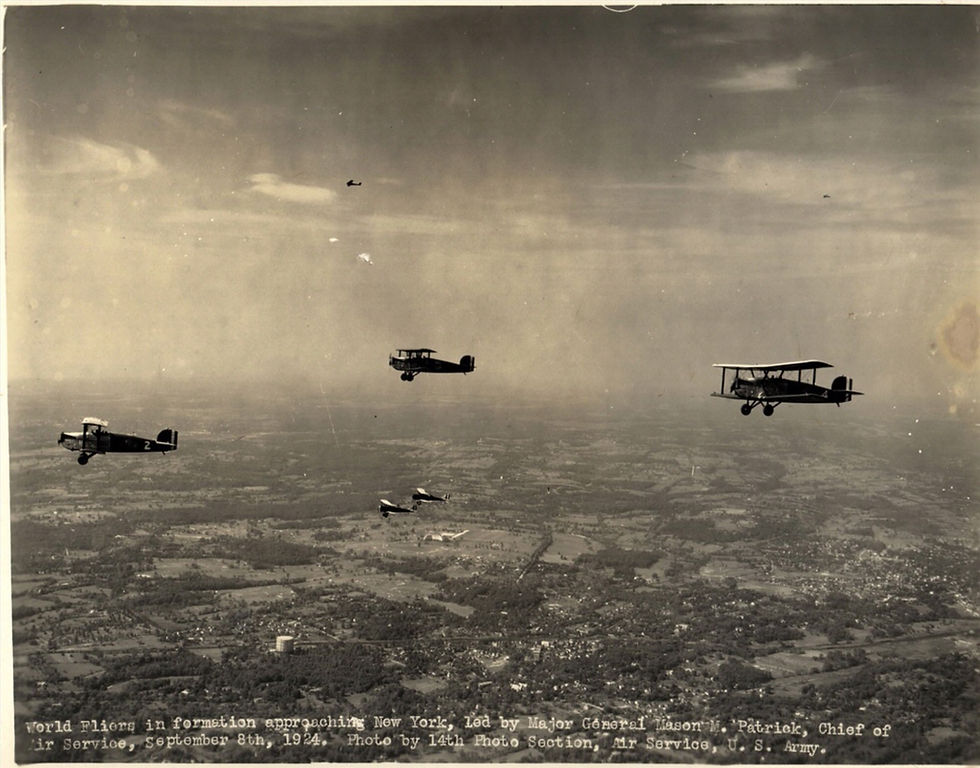This Day in History: Douglas World Cruisers (part 2)
- tara
- Sep 29, 2022
- 3 min read
On this day in 1924, U.S. Army Air Service pilots celebrate success. They’d just completed the first aerial circumnavigation of the globe!
Four planes had attempted the trip, but not every plane made it. One, the Seattle, had crashed less than a month after the pilots departed on April 6, 1924. (See yesterday’s post.)
The crews of the other planes (Chicago, Boston, and New Orleans) had been in Dutch Harbor, Alaska, waiting for Seattle to catch up. Now they would complete the trip without her.

The American crews were to “bid farewell to the Aleutian Islands and North America,” historian Lowell Thomas explains, “and attempt to fly all the rest of the way across Bering Sea and the Pacific to Japan, a feat never before attempted, and destined to be one of the most historic episodes of man’s first flight around the world.”
The landing in Japan made them the first to cross the Pacific by air.
The intrepid pilots continued their flight across Asia, then the Middle East, and into Europe. Often, huge crowds waited to greet them. Once, Chicago was forced to make an emergency landing in a small lagoon. That adventure ended with canoes pulling the plane back to safety and repairs. On another occasion, a reporter stowed away in Boston’s luggage compartment.
The pilots liked him, so they just laughed.
Perhaps the worst moments came in early August, as the planes made their way toward Iceland. New Orleans found itself in trouble: It got caught in the wash of one of the other planes and “went into a spin, partially out of control, came out of it just above water,” New Orleans’s pilot, Lt Erik Nelson, cabled after he landed.
He’d made it to Iceland, despite the scare, but Boston and Chicago weren’t there yet. They’d returned to England for help when they lost New Orleans. They’d have to attempt the leg to Iceland again.
Unfortunately, Boston began losing oil and was forced to land in the water.
Chicago went for help—again. Her pilot, Lt. Lowell Smith, knew that it would be difficult. He didn’t have a radio, and the water was too rough for him to land. Instead, he wrote two notes describing Boston’s situation. He’d found the Navy destroyer Billingsby nearby, and he would try to get their attention.
“The first note we put in a message bag and dropped on the Billingsby,” Lt. Leslie Arnold, Chicago’s mechanic wrote, “but she was making fully twenty knots and I missed her deck by several yards. We had only one note left . . . . It was imperative that this one should get to the destroyer, so I tied it to my one and only life preserver.”
He still missed the deck, but a sailor aboard Billingsby dived into the water and retrieved the message. Boston’s crew was saved, but the plane was lost.
Only two were left: New Orleans and Chicago. They still needed to complete a dangerous, icy trip from Iceland to Greenland, then Greenland to Canada.
An oil leak aboard Chicago nearly did that plane in, but Arnold manually pumped oil through her engines for four hours to keep her airborne. After he came ashore in Canada, he claimed his effort was “nothing at all,” but his arm and shoulder were numb.
His arm had to be massaged for two hours.
It would take the pilots more than three weeks to finish their journey across the continental United States. Excited crowds greeted them at each stop.
The exhausted pilots finally landed in Seattle, back where they’d started, on September 28.
“Your countrymen are proud of you,” Calvin Coolidge told them. “Your branch of the Service realizes the honor you have won for it.”
Enjoyed this post? More stories of American
aviators can be found on my website, HERE.
Primary Sources:
1924 Round-the-World Fliers Complete Their Mission (National Archives; Sept. 28, 2010)
1924 World Flight Chronicle (The Seattle World Cruiser Project website)
A Brief History Of The First Flight Around The World (The Seattle World Cruiser Project website)
A Look Back: First Around-The-World Flight: 6 April--28 September 1924 (R. Ray Ortensie ed.; Air Force Materiel Command History and Heritage Program) (More info HERE)
First Flight Around the World (National Air and Space Museum)
First Flight Around the World (National Museum of the Air Force) (archived HERE)
First Flight Around the World: The Douglas World Cruisers at Pearson Field (National Park Service website)
Joshua Stoff, Transatlantic Flight: A Picture History, 1873–1939 (1999)
Lowell Thomas, The First World Flight: Being the Personal Narratives of Lowell Smith, Erik Nelson, Leigh Wade, Leslie Arnold, Henry Ogden, John Harding (1925)
Rob Crotty, Magellans of the Sky (Prologue Magazine; 2010) (reprinted HERE)
The Douglas World Cruiser - Around the World in 175 Days (U.S. Centennial of Flight Commission)
U.S. Fliers Tell of Flights From Iceland Harbor (Asheville Citizen-Times; Sept. 3, 1924) (p.5)



Comments